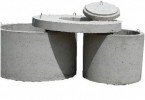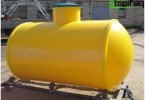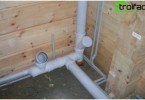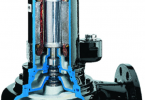Autonomous sewage
Meet today a house with traditional past street toilets It’s almost impossible, because most owners of private houses try first of all to organize an autonomous sewage system that would provide them with comfortable living. Autonomous sewage allows not only not to think about where, how and when to dump the waste, but also helps to neutralize it, creating a healthy and clean atmosphere around the house. But before you start developing a project for a future sewer system, you need to clearly determine for yourself how much waste water will be drained into it, in order to avoid problems in the future.
Content
- Classification of sewer systems
- Cesspool and its device
- Calculation of the volume and depth of the cesspool
- The construction of the simplest sewage system
Classification of sewer systems
Of course, any sewage system, whether autonomous or not, always has its own characteristics. It is impossible to find two identical ones. That is why they can be classified endlessly. However, there are still some points that allow you to divide the sewage system into several types.
- Depending on the electricity, sewer systems are:
- The volatile autonomous sewer system is characterized in that it is small in size, which makes it possible to place it even on the smallest area. Thanks to the pump (compressor), all processes in it proceed quite quickly. It is the presence of the pump that makes such systems dependent on electricity. In addition to periodic cleaning, this type of sewage system requires quarterly maintenance, which makes them a rather expensive pleasure..
- Non-volatile sewage system is absolutely nothing (well, except for a person, of course) an independent system in which all processes take place independently, that is, by gravity. Naturally, the cleaning and filtering, in this case, lasts much longer, and the size of such a system is much larger.
2. By type of construction:
- cesspool
- overflow well structure
- autonomous sewage system with bio-treatment function
Cesspool and its device
The simplest type of sewage system is the classic cesspool, which for several centuries has been successfully used not only in Russia, but also in other countries. This type of sewage, of course, has undergone significant changes, which only benefitted it..
Before proceeding with construction, you should choose a place for cesspool, only it is necessary to consider that it is possible that some of the water will nevertheless seep into the ground and further into the groundwater. Therefore, be sure to find out what is the depth of the groundwater in your chosen place..
Important: if the groundwater depth is less than 2 meters, you cannot build a cesspool in this place.
If there is a sump on a well site, it is advisable to place it at a decent distance – ideally at least 30 meters. If the possibilities of your site are not so vast, then place the sewer diagonally in order to avoid accidental leakage of harmful effluents into clean drinking water.
Calculation of the volume and depth of the cesspool
Any autonomous sewage of a private house, including a cesspool, should begin with calculations. For a small family of three to four people, the most optimal volume (given that about 250 liters of water per person per day) will be a volume of 1.5 cubic meters. meter.
In any case, even if the volume of the cesspool is smaller, periodic cleaning will be necessary, that is, a call for a sewage machine. Consider also the presence in the house of an automatic washing machine and dishwasher (if there is, of course), which also contribute to a fairly quick filling of the sump.
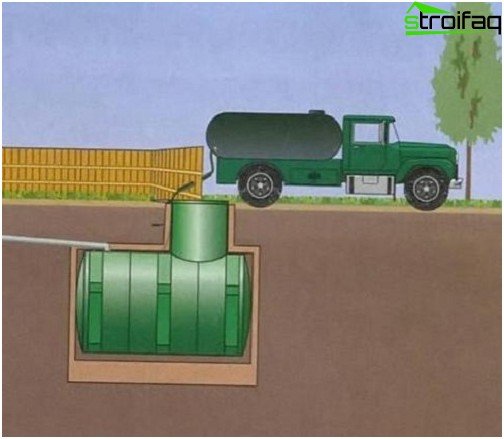
Septic tank for autonomous sewage
Another factor that can determine the size of the sewage system is the construction of the cesspool itself. If it has an additional absorbing hole, then part of the effluent will go into the soil, which will significantly “increase” its size. With small volumes, such a sewage system will not harm either man or nature.
Such an absorbing hole is usually made small in size, since the function of accumulating sewer masses, in this case, disappears. However, the soil can cope only with a small amount of waste and decomposition products, when large volumes leak out, it first poison itself, and then spreads this effect to the surrounding space and even people. You can, of course, apply peat powdery clump (a pillow made of peat. Which is laid at the bottom of the pit), which will eliminate the harmful fecal component of wastewater. In this case, in addition to cleaning the drains, you will get an excellent compost for beds.
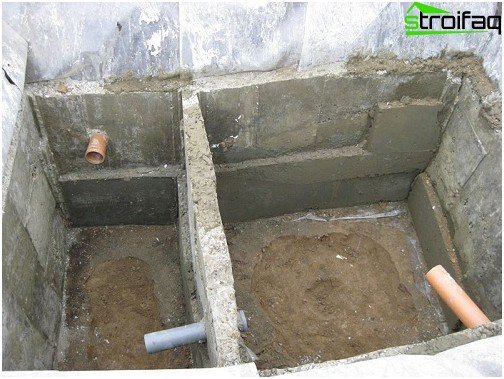
Autonomous sewage device (cesspool)
The construction of the simplest sewage system
An autonomous sewage system, in particular a cesspool, is simple, but it can take a lot of time and effort from you, unless, of course, you decide to drive heavy equipment to the site.
- The first stage of work – pipe laying. There is nothing complicated here, the main condition that must be observed is to adhere to a constant slope of 3-5 degrees so that the water flows without problems and there is no siltation. Please note that the longer the pipe, the greater the angle of inclination.
- The second stage of work. The walls of the pit are carefully aligned, and the bottom is made with a slight slope to the side where you intend to make a hatch for pumping drains.
Usually they dig a hole in a square or rectangular shape, less often round, but you will have to determine the dimensions yourself.
The bottom of the pit is lined with sand with a layer of about 15 cm. Concrete is poured on top of such a pillow no less than the thickness of the sand. After setting concrete, it is necessary to make a sand-cement screed of 4 cm on it. If possible, you can not bother and just lay the finished concrete slab at the bottom of the dug hole.
The walls of the pit can be laid out with burnt bricks or metal or concrete rings can be installed in it, since today you can buy anything you like.
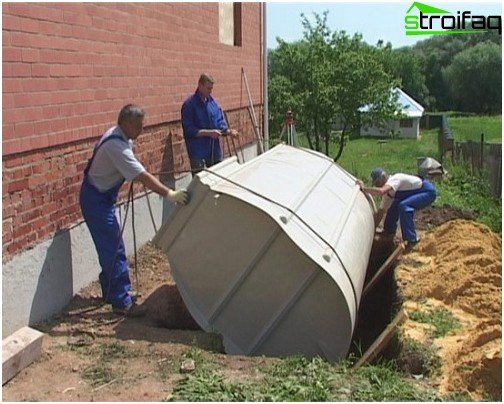
Installation of a septic tank for autonomous sewage
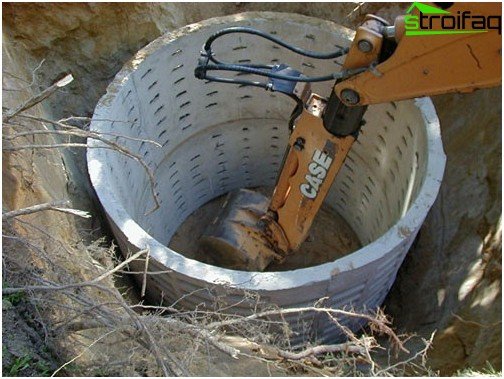
Installation of concrete rings in a cesspool
- The third stage of work. After all the arrangements for the internal arrangement of the cesspool have been completed, you can proceed with the construction of the ceilings. They must be made of very strong and reliable material, for example, thick sleepers or any reinforced concrete structures.
From the sides, the pit should overlap by at least 40-50 cm, and the hatch for pumping out drains should have dimensions of about 70 * 70 cm.
Autonomous sewage of a country house is almost ready, it remains only to complete what has been started. The finished floor must be properly isolated from water. To do this, you need to use any waterproofing material, for example, roofing material, which is laid on top of plates or sleepers. On top of the roofing material, soil, sand, slag (in general, whatever you want) are poured with a layer of about 40 cm.
Be sure to make a cover that will reliably protect you from unpleasant odors. It is desirable that it be double – one at ground level, and the second at the level of overlap. In winter, the space between the two covers is covered with slag, polystyrene, straw or any other insulation, thereby protecting the drains from freezing, and you from unnecessary waste of money, time and effort.
If autonomous sewage with your own hands is not a problem for you and you are ready for the upcoming work, then a cesspool is the simplest and easiest way. You can build such a system in a week, and most of the time you spend on digging the hole itself.
Autonomous sewer system on the principle of overflow wells
Such a system consists of two wells: the first serves as a settler for solid waste, and the second as an infiltrator.
The first well is made of concrete or metal rings with a cement bottom, or a ready-made septic tank made of plastic is installed on the bottom of the pit. The second well has no bottom at all, but is lined with rubble or gravel. The liquid purified from solid elements enters through the pipe into the absorbable well, where it is absorbed into the soil.
During operation of such an autonomous sewage system, it is necessary to pump out sludge from the first well once a quarter, otherwise stagnation will form. But you can reduce the number of calls of the sewage machine to once every six months, if you use special biological products that break down solid fractions.
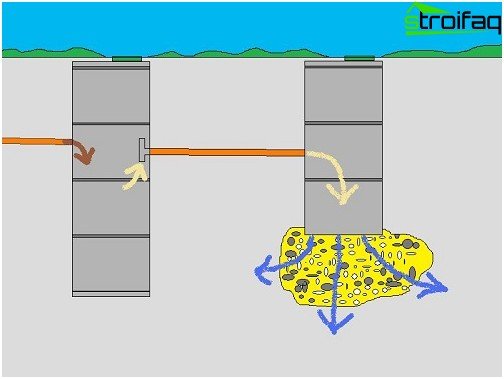
Overflow wells
The use of a system of overflow wells is possible only for small country houses with a daily volume of drains of not more than 1,500 liters. Large cottages and mansions should be equipped with other facilities, for example, sewers with the function of biological treatment.
Independent sewage with bio-treatment function
Autonomous sewage systems with their own bio-treatment station are a septic tank, which includes a large storage tank and a filtration field that collects all contaminants and waste. Such a sewage system is currently considered the most modern and efficient, but its cost is much higher than the first two systems described above.
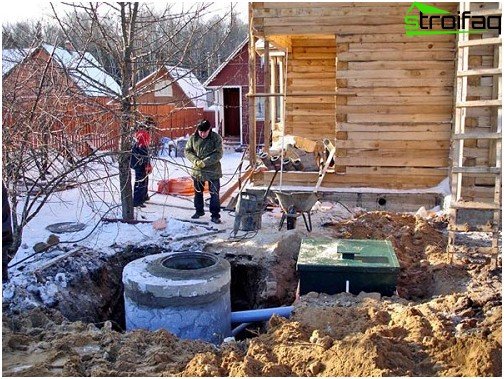
Autonomous sewage system with biological treatment
Thanks to the biological treatment plant, which may have a chemical, biological or mechanical nature, wastewater treatment and accumulation of sediments.
- The chemical method of wastewater treatment is based on the use of a variety of chemicals that change the structure of the liquid that has fallen into the septic tank into a solid state. These elements eventually settle to the bottom of the tank. This technology, although suitable for a country house, is still more common in large industrial enterprises, where the dosages of chemicals are clearly observed..
- A sewage system with mechanical self-cleaning can be found in cottages and suburban areas with small volumes of wastewater, for example, if the owner of such a house does not live there permanently and arrives on the weekend. This method of installation does not require high financial costs, you only need to periodically replace crushed stone gutters and occasionally cleanse the septic tank from solid sediments.
- The biological method of cleaning the sewage system is based on the use of bacteria that decompose organic and inorganic waste, turning them into sludge, water and carbon dioxide. Such a system can be additionally equipped with a frame-reserve filter, a UV disinfection mechanism and a drainage pump..
Any autonomous sewage system, reviews of which you can find in large numbers on the Internet, requires not only careful care and control, but, above all, high-quality assembly. Therefore, be sure to develop a scheme for the future sewer system, outline a plan and think about where and how it will be located.
This approach to work will certainly bring only positive results..


